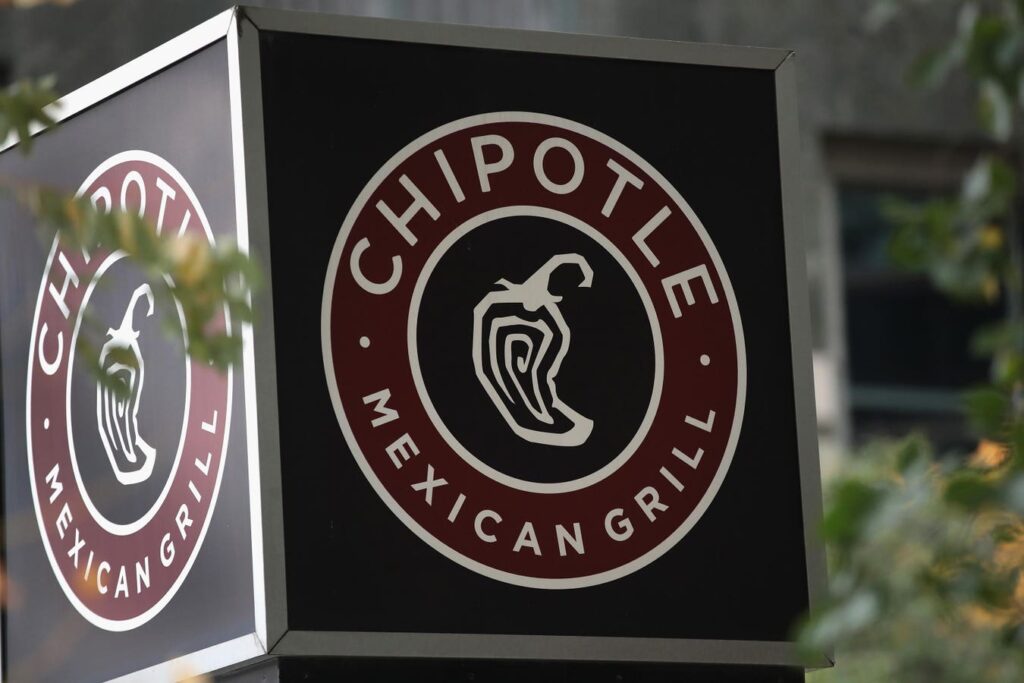Chipotle Mexican Grill (NYSE: CMG) has declined 15% year-to-date, most notably underperforming the S&P 500’s modest 1% gain. In the first quarter, revenue increased 6% to $2.88 billion, while adjusted EPS increased 7% to $0.29. Nevertheless, comparable-restaurant sales fell 0.4%, mainly due to a 2.3% decrease in transactions, even with a 1.9% rise in average check size. Operating margins compressed by 130 basis points to 26.2%, impacted by rising food and labor expenses, as well as larger portion sizes. Additional challenges include a projected 50-basis-point margin effect from tariffs. Looking forward, Chipotle forecasts a challenging second quarter because of difficult comparisons against last year’s 11.1% comp growth and the timing of a late Easter. For the full-year 2025, the company expects low single-digit comparable sales growth, with traffic anticipated to become positive in the second half.
That being said, CMG stock seems expensive at its current value of approximately $51. Although the operational performance remains strong, minor concerns and high valuation levels indicate limited upside. See Buy or Sell Chipotle stock?
Our evaluation, based on Chipotle’s historical and present financial status across key dimensions such as growth, profitability, financial stability, and resilience, supports a cautious position. For investors looking for more stable returns with less volatility, the Trefis High Quality Portfolio could provide an attractive alternative, having outperformed the S&P 500 with over 91% returns since inception.
How does Chipotle Mexican Grill’s valuation look vs. the S&P 500?
Based on what you pay per dollar of sales or profit, CMG stock seems expensive compared to the overall market.
• Chipotle Mexican Grill has a price-to-sales (P/S) ratio of 6.1 versus a figure of 2.8 for the S&P 500
• Furthermore, the company’s price-to-free cash flow (P/FCF) ratio is 32.6 compared to 17.6 for S&P 500
• Additionally, it presents a price-to-earnings (P/E) ratio of 44.7 versus the benchmark’s 24.5
How have Chipotle Mexican Grill’s revenues grown over recent years?
Chipotle Mexican Grill’s Revenues have experienced significant growth over recent years.
• Chipotle Mexican Grill’s revenue has grown at an average rate of 14.4% over the last 3 years (compared to an increase of 6.2% for S&P 500)
• Its revenues have grown 14.6% from $10 Bil to $11 Bil in the past 12 months (compared to 5.3% growth for S&P 500)
• In addition, its quarterly revenues grew 6% to $2.9 Bil in the most recent quarter from $2.7 Bil a year ago (compared to a 4.9% improvement for S&P 500)
How profitable is Chipotle Mexican Grill?
Chipotle Mexican Grill’s profit margins are around the median level for companies in the Trefis coverage universe.
• Chipotle Mexican Grill’s Operating Income over the last four quarters was $2.0 Bil, which indicates a moderate Operating Margin of 17.5% (compared to 13.1% for S&P 500)
• Chipotle Mexican Grill’s Operating Cash Flow (OCF) over this period was $2.1 Bil, reflecting a moderate OCF Margin of 18.6% (compared to 15.7% for S&P 500)
• For the preceding four-quarter period, Chipotle Mexican Grill’s Net Income was $1.5 Bil – indicating a moderate Net Income Margin of 13.6% (compared to 11.3% for S&P 500)
Does Chipotle look financially stable?
Chipotle Mexican Grill’s balance sheet appears strong.
• Chipotle Mexican Grill’s Debt figure was $4.5 Bil at the close of the most recent quarter, while its market capitalization stands at $70 Bil (as of 5/20/2025). This suggests a strong Debt-to-Equity Ratio of 6.6% (compared to 21.5% for S&P 500). [Note: A low Debt-to-Equity Ratio is desirable]
• Cash (including cash equivalents) constitutes $1.4 Bil of the $9.0 Bil in Total Assets for Chipotle Mexican Grill. This leads to a strong Cash-to-Assets Ratio of 15.5% (compared to 15.0% for S&P 500)
How resilient is CMG stock during a downturn?
CMG stock has experienced an impact that was slightly better than the S&P 500 index during certain recent downturns. While investors hope for a soft landing of the U.S. economy, how severe could the situation become if another recession occurs? Our dashboard How Low Can Stocks Go During A Market Crash illustrates how key stocks performed during and following the last six market crashes.
Inflation Shock (2022)
• CMG stock dropped 38.1% from a peak of $38.88 on 23 September 2021 to $24.08 on 14 June 2022, compared to a peak-to-trough decline of 25.4% for the S&P 500
• The stock fully recovered to its pre-Crisis peak by 26 April 2023
• Since that time, the stock has increased to a peak of $68.55 on 19 June 2024 and currently trades at approximately $51
Covid Pandemic (2020)
• CMG stock fell 50.2% from a peak of $18.68 on 19 February 2020 to $9.30 on 18 March 2020, compared to a peak-to-trough decline of 33.9% for the S&P 500
• The stock fully recovered to its pre-Crisis peak by 11 May 2020
Global Financial Crisis (2008)
• CMG stock dropped 74.6% from a peak of $3.05 on 26 December 2007 to $0.77 on 20 November 2008, compared to a peak-to-trough decline of 56.8% for the S&P 500
• The stock fully recovered to its pre-Crisis peak by 15 June 2010
Putting all the pieces together: What it means for CMG stock
In summary, Chipotle Mexican Grill’s performance according to the parameters outlined above is as follows:
• Growth: Very Strong
• Profitability: Neutral
• Financial Stability: Very Strong
• Downturn Resilience: Neutral
• Overall: Strong
However, considering its very high valuation, the stock appears relatively expensive, which corroborates our conclusion that CMG is an expensive stock to purchase.
The high valuation of CMG stock restricts its upside potential in the near-to-mid term. As an alternative, the Trefis Reinforced Value (RV) Portfolio has outperformed its all-cap stocks benchmark (a combination of the S&P 500, S&P mid-cap, and Russell 2000 benchmark indices) to deliver robust returns for investors. What accounts for this? The quarterly rebalanced mix of large-, mid- and small-cap RV Portfolio stocks offers a flexible approach to capitalize on favorable market conditions while mitigating losses when the markets decline, as elaborated in RV Portfolio performance metrics
Read the full article here
















